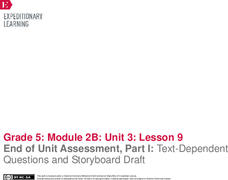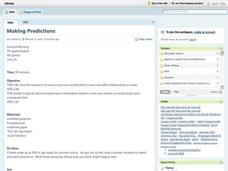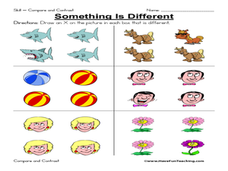Carnegie Library
Creative Writing: Middle School Lesson Plan
Enhance a unit on historical fiction with an engaging writing lesson. Learners bring the Industrial Era to life as they compose their own historical fiction pieces based on primary source images of Pittsburgh steel workers.
Museum of Tolerance
Cultural Research Activity
Class members explore cultural diversity through a variety of texts that showcase the importance of traditions. Then, they interview their family members to research their own cultural background and write their findings on quilt pieces....
EngageNY
End of Unit Assessment, Part 1: Text-Dependent Questions and Storyboard Draft: “You Can Do a Graphic Novel” Excerpt
Eyes on the finish line. Serving as the first part of the end of unit assessment, learners answer questions based on a text about how to write a graphic novel. Using what they've learned, they then create a storyboard about the invention...
Utah Education Network (UEN)
7th Grade Poetry: I Am Poem
A study of Alfred Noyes's poem "The Highwayman" opens a lesson plan about narrative poetry. Scholars read the poem and compare it to the animated video version using a worksheet. Learners look at models and use a template to craft an "I...
Museum of Tolerance
Where Do Our Families Come From?
After a grand conversation about immigration to the United States, scholars interview a family member to learn about their journey to America. They then take their new-found knowledge and apply their findings to tracking their family...
PBS
Copyright and Fair Use
When is using someone else's copyrighted material appropriate? Learn about copyright and fair use with a lesson from PBS.org. Scholars read through a reference sheet about authors' rights and users' rights, and then create posters for a...
Curated OER
Going West
Young scholars examine the lives of early pioneers who traveled west for better opportunities. They listen to story "Josafina and the Story Quilt", and discuss hardships encountered by traveling families. Students then complete research...
Curated OER
Animal: Unique Creatures With Great Features
Pupils present models, oral reports, and presentations on animal's characteristics. They research various animals and the characteristics that link them to specific animal groups. They answer specific questions relating to animals in...
Curated OER
Making Predictions
Seventh graders read stories, stopping periodically to make predictions. They discuss how the sequence of events, as well as cause and effect, can give hints to the outcome of the story. In addition, 7th graders use logic and...
Curated OER
All About Me
Students explore autobiographical stories. They write about a personal experience that is significant and memorable. Students specifically explain the chosen events. They define autobiography and share their stories.
Curated OER
Harriet The Spy
Fourth graders investigate the style of diary writing as its own genre of literature. They read Harriet The Spy in order to have a text for this literature study. Students use the skill of prediction to preview the story, and then...
Curated OER
Open Your Eyes Wide-Shut
Students improve their language skills through 11 activities. In this language skills lesson, students listen to picture books, answer questions about elements of a story, enhance their vocabulary and grammar skills, use 5 W questions,...
Curated OER
Steps to Freedom
Students complete discussion and reading comprehension activities for the novel Almost to Freedom by Vaunda Micheax Nelson. In this African American history lesson, students discuss the Underground Railroad and complete a reading...
Curated OER
Narrative Prompt - Lesson 2
Second graders review the structure of a narrative piece of writing. Individually, they write a narrative based on their best day of school. After being read different stories, they share their own narratives with the class. They are...
Curated OER
Character Education-Honesty
First graders learn the importance of honesty as they practice problem solving, listening, and sequencing skills. The lesson uses the story, " Too Many Tamales."
Curated OER
Butterfly Life Cycle
Students read books about animals and describe their structures, how they grow and change, and their life cycles. In this animals lesson plan, students also make animals out of pasta.
Curated OER
Identifying Differences Between Fiction and Nonfiction Books
Learners explore the differences between fiction and non-fiction book. In this genre study activity, students read examples of fiction and non-fiction and identify the characteristics of each genre. Learners list the characteristics on a...
Curated OER
Something is Different: Same/Different
In this different/same worksheet, student draw an X on the picture in a box that is different from the others, 6 sets total. A reference web site is given for additional activities.
Curated OER
Inferring Themes
Fifth graders practice making inferences on various types of reading material. As a class, they develop a definition of the word "theme" and discuss themes for some of their favorite stories. They use the context of the reading...
Curated OER
Then What Happened?
Students complete activities about the story "Diary of a Worm", by Doreen Cronin. In this reading comprehension lesson, students make predictions and apply prior knowledge about the topic of the story. They actively listen as the book is...
Curated OER
Jack and the Beanstalk
In these reading comprehension worksheets, students complete several activities to help them learn about Jack and the Beanstalk. Students complete a cloze exercise, a reading comprehension activity, a story sequencing activity, and an...
Curated OER
Awesome Adventures Book Report Directions
In this book report direction worksheet, learners fill in the title, author, illustrator, and publisher of a book. They complete a book report based on the adventures of the main characters by answering the rest of the questions listed...
Curated OER
How Worldly Are You?
Sixth graders locate and map six components to have a working knowledge of maps. In this map skills lesson, 6th graders define the six map components and work in groups to draw a map using the components. Students read a related story...
Curated OER
Narrative Literature Response Letters
Third graders write endings to a story that has already been written. They offer alternative endings in their version. The lesson includes a rubric that is to be given to the students in order that they know the requirements.

























